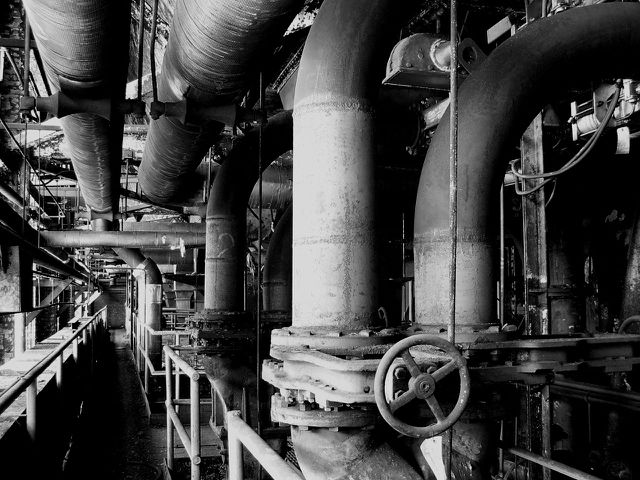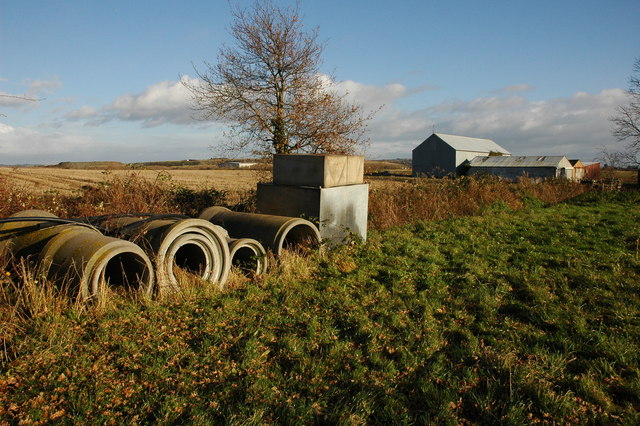Liquid Farm: Difference between revisions
No edit summary |
m (fixed broken int. link) |
||
| (45 intermediate revisions by the same user not shown) | |||
| Line 1: | Line 1: | ||
[[ | [[Category:Food and Agriculture]] | ||
[[Category:Transport]] | |||
[[Category: Materials]] | |||
[[Image:Pipes liquid farm.jpg|640px|thumb|right| Pipes everywhere on the liquid farm. The concept of aquaponics is extended further, to involve additional goods and processes.]] | |||
== | This is a concept in which bulk raw materials are transported all over the farm in liquid or gaseous form via pipelines. The concept is similar to [[aquaponics]] but extends to involve a wider variety of goods. Products are moved by pumps or by a gravity differential. Pumps may be powered electrically or mechanically using wind energy. Once this pipeline infrastructure is set up, it can save labor, time, energy and costs (see "design principles" below). It provides extra security and independence. It can make use of otherwise stranded energy from solar, wind and biomass sources. Liquids may be easier to measure and monitor than solid products. | ||
* freshwater, hot water | |||
* | ==Examples of transported liquids and gases== | ||
* wastewater from fish farming | * rainwater, other freshwater, hot water | ||
* | * greywater (for [[cattails]]) | ||
* wastewater from fish farming: to grow vegetables, [[duckweed]], [[azolla]] and [[cattails]] | |||
* liquid manure (from cows, pigs): [[cattails]] | |||
* slurry from [[biogas]] production | * slurry from [[biogas]] production | ||
* steam, superheated steam | * compost leachate, [[silage]] leachate, [[Compost Tea]] | ||
* [[ | * steam, superheated steam (will not stay superheated for very long unless very well insulated) | ||
* CO2-rich air (from compost, used for CO2 enrichment/fertilization) | * [[Compressed Air]] | ||
* biogas, methane, pyrolysis gas (“wood gas”) | * CO2-rich air (drawn from compost, used for [[CO2 Enrichment|CO2 enrichment]]/fertilization) | ||
* pyrolysis | * [[biogas]], methane, pyrolysis gas (“wood gas”), hydrogen. | ||
* [[Pyrolysis Oil]] (may be viscous, depending on distillation stage) and [[pyrolysis]] gas (wood gas, etc.) | |||
* vented gases/air for cleaning: pipe them under pressure into soil [[biofilter]] to reduce bad odors and airborne pathogens (examples incl. vented gas from: [[silage]], pig/cattle housing, composting facility, [[biogas]] facility, exhaust gases from combustion, etc.); see [https://patents.google.com/patent/US2793096A/en US Patent #2,793,096 (1957)]. This approach was investigated in the 1980s by the [https://en.wikipedia.org/wiki/New_Alchemy_Institute New Alchemy Institute] in a composting/greenhouse combination (for more detail: see [[biofilter]] page). | |||
[[Image:Drain pipes.jpg|640px|thumb|right| Large ceramic pipes, in this case drainage pipes, as well as smaller polyethylene pipes.]] | |||
==Needed Technologies== | ==Needed Technologies== | ||
* | *Pipes: polyethylene (for most things), terracotta (local, low-tech, more failure-prone), steel pipes, copper pipes (for wood gas), cement/lime+fabric composite | ||
*Electric motors (for pumps and fans), wind-driven pumps | *Electric motors (for pumps and fans), wind-driven pumps | ||
* [[ferrocement]] for bulk storage of liquids | *[[ferrocement]] and CEBs for bulk storage of liquids in tanks | ||
* useful: [[Solar Sludge Drying]] system | |||
* useful: [[Gas Holder]] to store and pressurize gases | |||
*sensors (see below: "monitoring") | |||
*PCR and [https://en.wikipedia.org/wiki/Metagenomics metagenomics] equipment (see below: pathogen monitoring, microbial monitoring) | |||
==Examples== | ==Examples== | ||
* liquid manure => [[duckweed]] => cattails | * liquid manure => [[duckweed]] => cattails => for irrigation or through (bio-)filter and then return to cycle | ||
* aquaponics (e.g. fish culture | * aquaponics (e.g. fish culture, then use wastewater for duckweed/[[azolla]]) | ||
* compressed air => aerate compost => capure CO2-rich, hot off-gas => greenhouse | * compressed air => aerate compost => capure CO2-rich, hot off-gas => greenhouse | ||
* CO2 pipelines for CO2 enrichment for the entire farm (source: compost or [[biogas]]). CO2 retained by wind breaks such as walls (see: Victorian [https://en.wikipedia.org/wiki/Walled_garden walled garden]). | |||
* methane => [[synfood]] | |||
* various filtering methods: soil [[biofilter]], [[Bone Char]], | |||
* integration of a [[biorefinery]] into the farm. | |||
==Liquid Farm Design Principles== | |||
'''1.) Efficiency: spatial, material, resource efficiency''' | |||
*minimize distances: co-locate production and use of a resource | |||
*minimize needed infrastructure with dual use (e.g. use same pool for [[tilapia]] and [[duckweed]] but with barrier in-between) | |||
*try to minimize resource losses (e.g. heat losses, nitrogen losses, water losses, etc.) | |||
*channel resources to the most productive use | |||
*minimize energy expenditure (e.g. instead of electric fans, try to use thermal expansion from solar or biological processes to move large amounts of air/exhaust) | |||
'''2.) Resilience''' | |||
*(NB: economists know that ''resilience and efficiency are often at odds'') | |||
*create buffers | |||
*storage (e.g. cisterns, dry biomass storage, wood, water, etc.) | |||
*backup mechanisms (e.g. use muscle-powered pump if solar fails) | |||
'''3.) Flexibility and Expandability''' | |||
*multi-use of the infrastructure (e.g. drain cattail pool and then plant wheat or corn in the nitrogen-rich mud) | |||
*favor products that have multiple uses (e.g. [[duckweed]] which can be fed to various animals) | |||
*ability to quickly ramp up or down production of intermediates or finished products (e.g. have compostable but dry biomass ready for composting in anticipation of quick need for heating, CO2 and fertilizer) | |||
*Expandability: keep options open for future expansion | |||
'''4.) Interconnectedness''' | |||
*the more connections between various sub-systems, the more flexibility, resilience, responsiveness to market demands | |||
*interface with adjacent farms and the outside world | |||
'''5.) Easy access''' | |||
*for monitoring (see below) | |||
*for potential repairs to infrastructure | |||
*have ability to tap into resources at every step (for sale) | |||
'''6.) Data richness''' | |||
*monitor all resource flows | |||
*use predictions to channel flows in order to maximize yields and economic benefits | |||
'''7.) Monitoring''' | |||
*minerals, nutrients | |||
*nitrogen (ammonia, nitrite, nitrate) | |||
*temperatures, microclimatic conditions | |||
*ambient gases: CO2, methane, nitrous oxide | |||
*microbial monitoring (capability to sterilize liquids if needed; bioconversion towards beneficial microbes) | |||
*pathogens (see [http://www.appropedia.org/Low-Cost_Diagnostics Low-Cost Diagnostics]) | |||
*heavy metals (e.g. risk of HM buildup when [https://en.wikipedia.org/wiki/Hyperaccumulator hyperaccumulating] plants are part of a cycling system) | |||
Latest revision as of 19:32, 23 August 2016
This is a concept in which bulk raw materials are transported all over the farm in liquid or gaseous form via pipelines. The concept is similar to aquaponics but extends to involve a wider variety of goods. Products are moved by pumps or by a gravity differential. Pumps may be powered electrically or mechanically using wind energy. Once this pipeline infrastructure is set up, it can save labor, time, energy and costs (see "design principles" below). It provides extra security and independence. It can make use of otherwise stranded energy from solar, wind and biomass sources. Liquids may be easier to measure and monitor than solid products.
Examples of transported liquids and gases
- rainwater, other freshwater, hot water
- greywater (for cattails)
- wastewater from fish farming: to grow vegetables, duckweed, azolla and cattails
- liquid manure (from cows, pigs): cattails
- slurry from biogas production
- compost leachate, silage leachate, Compost Tea
- steam, superheated steam (will not stay superheated for very long unless very well insulated)
- Compressed Air
- CO2-rich air (drawn from compost, used for CO2 enrichment/fertilization)
- biogas, methane, pyrolysis gas (“wood gas”), hydrogen.
- Pyrolysis Oil (may be viscous, depending on distillation stage) and pyrolysis gas (wood gas, etc.)
- vented gases/air for cleaning: pipe them under pressure into soil biofilter to reduce bad odors and airborne pathogens (examples incl. vented gas from: silage, pig/cattle housing, composting facility, biogas facility, exhaust gases from combustion, etc.); see US Patent #2,793,096 (1957). This approach was investigated in the 1980s by the New Alchemy Institute in a composting/greenhouse combination (for more detail: see biofilter page).
Needed Technologies
- Pipes: polyethylene (for most things), terracotta (local, low-tech, more failure-prone), steel pipes, copper pipes (for wood gas), cement/lime+fabric composite
- Electric motors (for pumps and fans), wind-driven pumps
- ferrocement and CEBs for bulk storage of liquids in tanks
- useful: Solar Sludge Drying system
- useful: Gas Holder to store and pressurize gases
- sensors (see below: "monitoring")
- PCR and metagenomics equipment (see below: pathogen monitoring, microbial monitoring)
Examples
- liquid manure => duckweed => cattails => for irrigation or through (bio-)filter and then return to cycle
- aquaponics (e.g. fish culture, then use wastewater for duckweed/azolla)
- compressed air => aerate compost => capure CO2-rich, hot off-gas => greenhouse
- CO2 pipelines for CO2 enrichment for the entire farm (source: compost or biogas). CO2 retained by wind breaks such as walls (see: Victorian walled garden).
- methane => synfood
- various filtering methods: soil biofilter, Bone Char,
- integration of a biorefinery into the farm.
Liquid Farm Design Principles
1.) Efficiency: spatial, material, resource efficiency
- minimize distances: co-locate production and use of a resource
- minimize needed infrastructure with dual use (e.g. use same pool for tilapia and duckweed but with barrier in-between)
- try to minimize resource losses (e.g. heat losses, nitrogen losses, water losses, etc.)
- channel resources to the most productive use
- minimize energy expenditure (e.g. instead of electric fans, try to use thermal expansion from solar or biological processes to move large amounts of air/exhaust)
2.) Resilience
- (NB: economists know that resilience and efficiency are often at odds)
- create buffers
- storage (e.g. cisterns, dry biomass storage, wood, water, etc.)
- backup mechanisms (e.g. use muscle-powered pump if solar fails)
3.) Flexibility and Expandability
- multi-use of the infrastructure (e.g. drain cattail pool and then plant wheat or corn in the nitrogen-rich mud)
- favor products that have multiple uses (e.g. duckweed which can be fed to various animals)
- ability to quickly ramp up or down production of intermediates or finished products (e.g. have compostable but dry biomass ready for composting in anticipation of quick need for heating, CO2 and fertilizer)
- Expandability: keep options open for future expansion
4.) Interconnectedness
- the more connections between various sub-systems, the more flexibility, resilience, responsiveness to market demands
- interface with adjacent farms and the outside world
5.) Easy access
- for monitoring (see below)
- for potential repairs to infrastructure
- have ability to tap into resources at every step (for sale)
6.) Data richness
- monitor all resource flows
- use predictions to channel flows in order to maximize yields and economic benefits
7.) Monitoring
- minerals, nutrients
- nitrogen (ammonia, nitrite, nitrate)
- temperatures, microclimatic conditions
- ambient gases: CO2, methane, nitrous oxide
- microbial monitoring (capability to sterilize liquids if needed; bioconversion towards beneficial microbes)
- pathogens (see Low-Cost Diagnostics)
- heavy metals (e.g. risk of HM buildup when hyperaccumulating plants are part of a cycling system)

